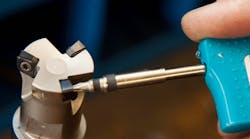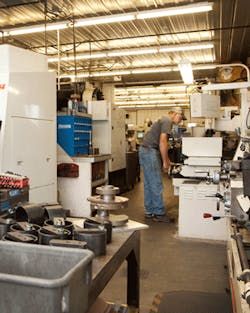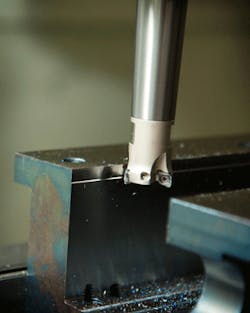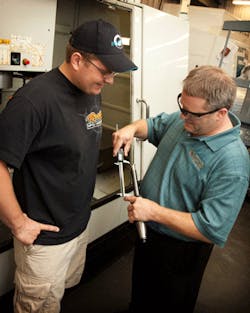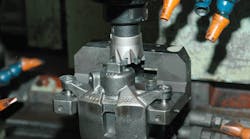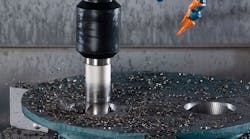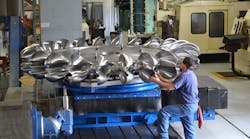Once you find a tool you trust, you’re may be tempted to use it for the next job, … and the next and the next, … just because it’s handy and you know what it can do. It’s like comfort food – warm in the tummy but not necessarily healthy. But, like watching your diet, it’s smarter to take a fresh look at each new job and find a new best practice.
Zack Hilton took that approach when it came time to mill a deep slot in a hardened part at River City Manufacturing and Machine Company (RCMM), in Winona, Minn. He’d had great success on a variety of milling jobs with an Ingersoll Hi-PosQuad indexable end mill, and pretty much made it his ‘go-to’ milling cutter in the busy, 20-man job shop that runs 20/5. Most of River City’s jobs are repeat orders in small lots for tools, molds, and various engine and machine parts.
When he tried out his mainstay cutter on the slot, Zack immediately recognized that there had to be a better way. The principle problem was early, unpredictable edge rupture, which he knew would cause a bottleneck in production for a part with good re-order potential. He could foresee having to stop and change inserts midway through the cut, leaving track marks on a surface with a very tight finish requirement. “Better to solve it at the outset and look beyond the familiar than settle for so-so efficiency,” he reasoned.
The specific job under consideration involved finish-milling a long, very deep slot in S-7 tool steel hardened to Rc 54-56. The purpose is to correct for any heat-treat distortion. It involves removing 0.020 inches from both sides, to +0.002/-0.000 inch, with a mirror finish. The finished part goes into a slide mechanism of a machine that fabricates chains. The 12-inch slot is nearly twice as deep as wide: 4.322 inches deep and 2.724 inches wide.
Fortunately, the Hi-PosQuad was part of an Ingersoll “Top-On™” modular tool family, so changing tools was simply a matter of screwing a different tip onto the existing five-inch threaded solid carbide shank. Then, the question became which of more than 50 tip styles available would be the best answer for this job.
Zack consulted immediately with Ondrej Lubinski, the Ingersoll field rep who walks the River City floor almost weekly. Their analysis: long-reach finish-milling job in hardened stock, to extremely close tolerances on both sides and the bottom. Because of the long reach, there’s always the risk that lateral cutting forces on the end of a long extension may cause chatter and excessive impact loads, leading to fracture on the brittle insert – or the shank itself.
Smaller Contact Area is Critical
“In this case the strategy should be to minimize the contact area between insert and workpiece, feed fast, and take very light cuts to avoid overloading any part of the system – tool, workpiece, fixture, or machine,” said Lubinski. “You’d be surprised at how quickly cutting forces rise with material hardness. The piece may look the same hard or soft, but looks are very deceiving.”
So, the search focused on tips with the same diameter as before but with a cutting action that would withstand higher feeds and speeds, yet minimize cutting forces. The solution: (1) start with a Form-MasterV backdraft cutter, with insert geometries that reduce the contact area between insert and workpiece; then, (2) run it much faster.
“Solely based on the throughput, the increased feed and speed would at least offset the reduction in cutting surface area,” said Lubinski. “So, the part should run at least as fast as before without overloading the insert to the point of fracture.”
They ran a trial on a single part, taking off the 0.020 inches per side in two passes. “The first pass is to get rid of the extra-hard crust characteristic of a heat treated part; the second is to bring the slot into exact size and finish,” said Hilton.
Here is the takeaway from the trial. With the previous 1-inch Hi-PosQuad end mill, the parameters were 1,400 RPM, 18 IPM, 0.005 in. DOC. The part took 20 hours to complete and required at least one indexing stoppage due to sudden, unpredictable edge fracture. With the Form-MasterV backdraft cutter, the comparable numbers are 2,600, 60, and 0.010, leading to a 4-hour cycle time. Most important, the inserts last through two full parts; the failure mechanism is gradual, totally predictable edge wear.
Entirely Different Insert Geometry
When the process first went from trial into production Hilton cut back a little on the settings, for peace of mind and a little more process security. For instance, the new cutter could handle a 0.010 inch depth of cut, yet Hilton runs at somewhere between that and the previous 0.005 inch. Nevertheless, edge life is up by 4 to 1 on average, and throughput is up by about 2 to 1.
To capitalize on that added security, he now runs the parts two-up, often overnight, completely unattended, radically improving the process economics. “We would have been happy with just the edge-life benefit,” said Hilton. “The throughput gain -- under lights-out conditions -- is icing on the cake.”
Hilton has pushed the parameters more recently, with no loss of edge life or process security.
Gains in the slot-finishing operation notwithstanding, RCMM still uses the Hi-PosQuad as its mainstay cutter, even on other long-reach applications using eight-inch shanks. Mainly, these jobs involve rough- and finish-milling for unhardened metals. “It’s a fine bread-and-butter cutter,” said Hilton. “We simply found a better fit for a particular finishing operation. The Form-MasterV backdraft cutter paid for itself out of savings after the first piece.”
It’s the difference in insert geometry that accounted for the improvement in this particular finishing operation. Unlike the 90-degree inserts in the Hi-PosQuad, Form-MasterV backdraft inserts are a rounded rhombic shape, so only the acute-angle radius and tiny wiper area -- not the entire side -- actually touch the work to make the chip. The shape provides backdraft on both the side and bottom of the cutter when inserts are clamped in place, ensuring that only the radius and small wiper touch the metal. The inserts are double sided, giving RCMM four useable edges per insert.
What’s the point of this example?
“Look at each new job with new eyes,” Zack Hilton offered. “What’s most comfortable may not be what’s best.”
“For long-reach finish milling, for slot milling, or for hardened stock alone, do everything possible to reduce the contact area between insert and workpiece,” Ingersoll’s Ondrej Lubiniski added. “It will reduce the lateral forces and protect the entire setup. When you encounter all three conditions at the same time, that strategy is three times more important.”
